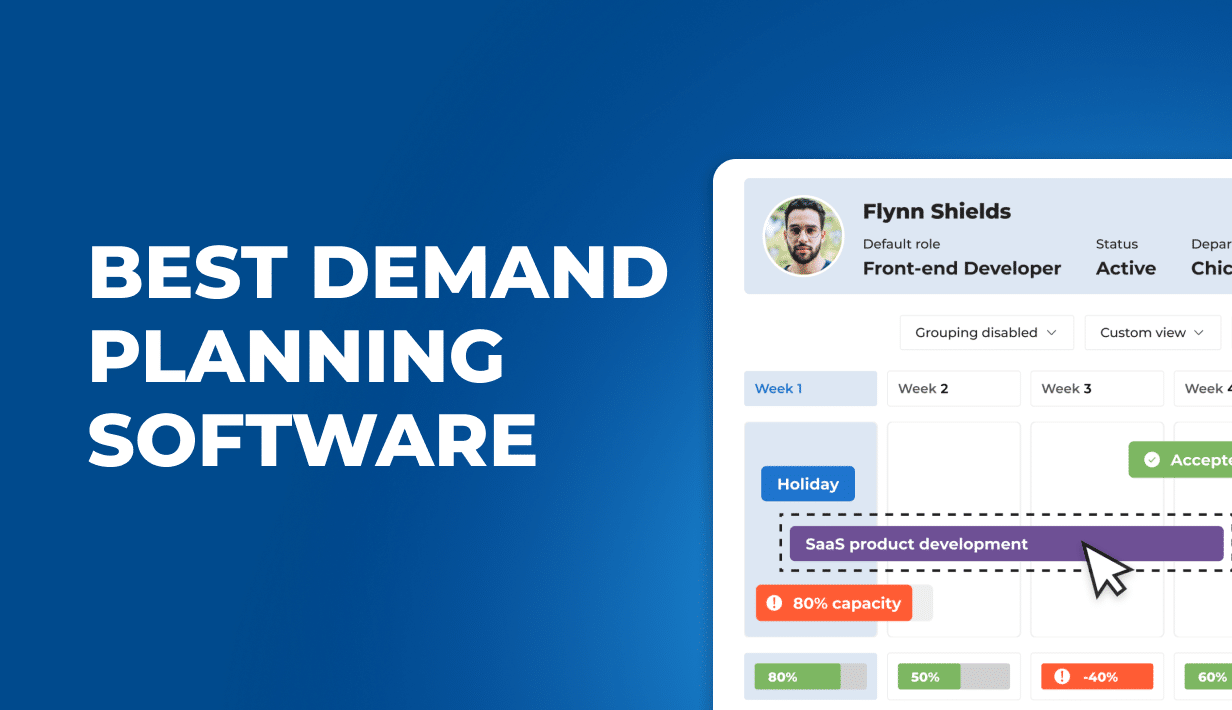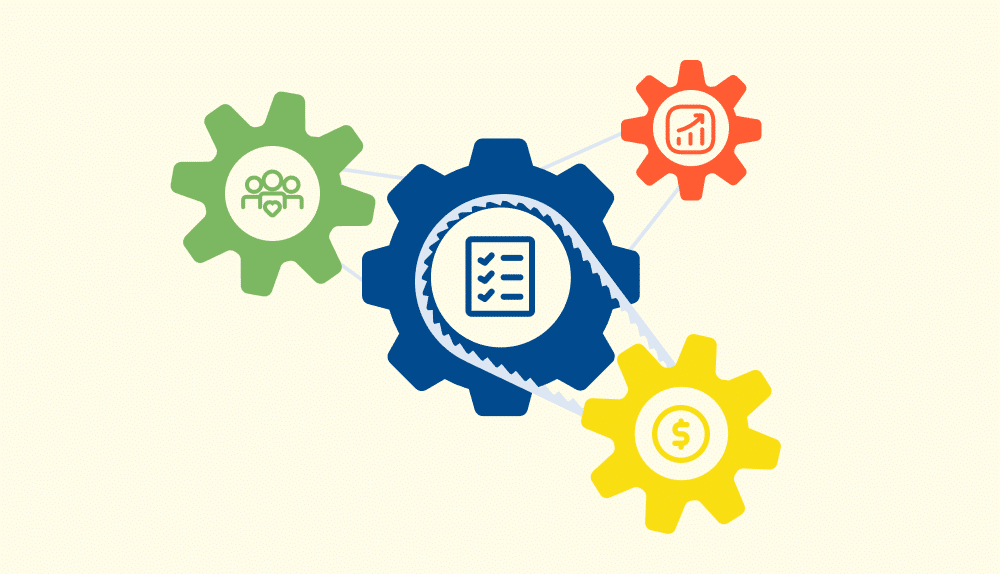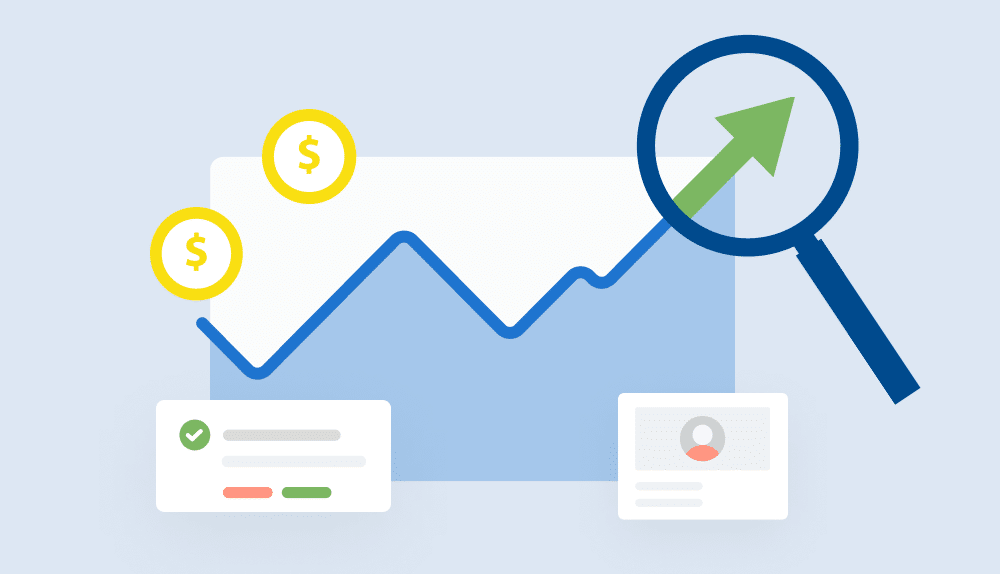Creating demand and supply plans is not a piece of cake with only Excel spreadsheet at hand. Fortunately, the process can get much easier with the best demand planning software on the market – and we know exactly what that is!
What Tools Should The Best Demand Planning Software Have?
Accurate demand forecasting and planning is more than a Gantt chart with simple allocations – although that’s definitely a backbone of any demand planning process. To ensure that your best demand planning tools can grow with your business and keep up with your teams as they expand, they should also have a variety of other tools supporting project managers in their everyday duties. That features should include:
- Advanced planning based on future customer demand and known demand patterns from similar projects supported by automated notifications on overbookings and schedule conflicts.
- Skill management with informations on employees’ skills, certifications and personal goals to ensure high staff renetion rates.
- Statistical and AI-based forecasting with scenario planning and testing (including project cost management), predictive analytics, and complete access to sales information on upcoming project and future demand, perfect for creating accurate forecasts regardless of the circumstances.
- State-of-the-art data management for both current and historical data, complete with advanced reporting, visualizations, interactive dashboards and AI features.
- Cost estimation and project budget creator based directly on the rates of employees assigned to a given project, as well as company overheads.
- Seamless integration with other tools collecting information on other external factors influencing the supply chain, including: invoicing, accounting, HR tools, and more.
The Best Demand Planning Software 2025: Ranking
Not all demand planning tools offer the full range of features required to ensure maximum forecast accuracy. To minimize risk, make informed decisions, and stay ahead of the competition, project managers should rely on only the most advanced solutions in the category—those that consistently turn accurate forecasts into higher customer satisfaction.
But which tools truly meet that standard, and which ones fall short? Our ranking reveals the answer.
BigTime
BigTime is a professional services automation (PSA) platform with advanced resource management and forecasting tailored specifically for consulting firms, accounting practices, IT services, and other project-based businesses profiting from the right use of their employees’ time.
BigTime is designed to monitor upcoming projects, forecast demand using sales data, simulate various scenarios, and support project managers in selecting the optimal project path. Simultaneously, it generates automated budgets based on predefined cost information and helps prevent common errors through intuitive notifications. In addition, BigTime offers advanced skill management, giving users a comprehensive view of team members’ skills, certifications, and career preferences.
The overview of the talent pool in BigTime
However, BigTime’s abilities doesn’t end there. The tool also offers a wide variety of additional tools, including time and expense tracking, project management, invoicing, and AI-powered reporting, giving the managers all they might ever need to monitor their business from bird’s eye view. Their oversight can be expanded even more with seamless integration with popular tools, allowing for an even more data-driven approach to forecasts, planning, and business management.
BigTime’s Demand Planning and Forecasting Features
As one of the best demand planning software, BigTime, offers a number of demand planning tools facilitating both project- and company-wide planning. Those include:
- Project-Based Forecasting: BigTime enables teams to project workload and forecast revenue based on upcoming and ongoing projects. It gives clear visibility into what’s in the pipeline and what resources will be needed.
- Instant Error Notifications: Whenever the system encounters a schedule conflict, it automatically informs the manager about the potential error, allowing them to avoid any
- Resource Allocation & Utilization: Assign staff based on availability, skills, and project needs, while tracking billable vs. non-billable hours in real time. Utilization rate metrics help ensure demand is matched with the right capacity.
- Time & Expense Tracking: Built-in tools make it easy for teams to log hours and expenses, helping forecast future project needs and margins more accurately, all while moniitoring project progress in advanced reports.
- Financial Forecasting: Estimate future revenue and costs with built-in budgeting and invoicing capabilities tied directly to planned project activities.
- Historical Data and Advanced Reporting: BigTime offers customizable reports with a variety of AI features, helping the managers obtain the information they need in just seconds.
- Integrated Workflow: Connects with tools like QuickBooks, Salesforce, and JIRA resource management, streamlining operations and data flow between sales, project delivery, and finance.
BigTime’s Demand Planning – The Key To More Accurate Forecasts
BigTime shines in its simplicity, intuitive design, and focus on practical use cases for professional services firms, allowing them to choose the best plan for every scenario. It bridges the gap between day-to-day project management and strategic planning, giving leaders a clear picture of upcoming resource needs without requiring complex modeling. It is also capable of scaling its processes indefinitely, making the most of every allocation in both small and large professional services companies.

Anaplan
Anaplan positions itself as a flexible, enterprise-grade planning platform, but for many professional services firms, its complexity often outweighs its benefits. While the tool offers powerful modeling capabilities and broad planning applications perfect for supply chain management, it is not purpose-built for services-based businesses. It also caters to the needs of large organizations, offering complicated tools even the most advanced users might struggle with.
Anaplan’s Demand Planning and Forecasting Features
Anaplan offers a variety of basic demand planning features
- Scenario Modeling: Users can simulate the impact of new clients, changing utilization rates, or resource constraints across multiple business dimensions.
- Custom Modeling: Build tailored models for project profitability, billable headcount, or service line performance. However, that feature requires a steep learning curve and includes little automation.
- Real-Time Updates: Cloud-based platform allows for real-time plan adjustments based on incoming data or stakeholder feedback.
- Integration: Works with some ERP, CRM, and HCM systems, adding even more complexity to the equation.
Anaplan’s Demand Planning – Summary
Despite a wide variety of resource planning features, Anaplan’s flexibility can be a double-edged sword. Custom model development often requires specialized knowledge of its proprietary modeling language, which slows down initial setup and makes ongoing maintenance dependent on a limited talent pool. Additionally, for many businesses, Anaplan’s features might not be of use at all. With complicated, rigit processes and limited ability to scale, this tool only caters to the need of the largest businesses, often leaving the aspiring companies with limited overview of their data.
Mavenlink
Mavenlink, now part of Kantata, markets itself as a purpose-built solution for demand forecasting for professional services firms. Still, in practice, it often falls short of delivering the depth and flexibility many firms require for strategic demand planning. For firms with complex planning needs or a strong focus on financial integration, Mavenlink can feel limited, especially as it prioritizes day-to-day project tracking over broader, forward-looking planning functionality.
Mavenlink’s Demand Planning and Forecasting Features
While Mavenling is definitely a demand forecasting software, its abilities to create a long-term predictions or plans are limited by its features aiming to shape demand in a short-term perspective.
Right now, the tool offers:
- Resource Demand Forecasting: Helps match resource availability with future project needs, factoring in skills, capacity, and location. However, it only offers basic revenue forecasting features, limiting visibility of both project and company budgets.
- Utilization Planning: Real-time insights into billable vs. non-billable hours, helping optimize staffing and profitability. Still, its capacity is usually based on default values (e.g., 40 hours/week), with limited ability to dynamically adjust for PTO, training, non-billable work, or seasonal availability.
- Performance Metrics: Dashboards track revenue, margin, and project performance KPIs across teams or service lines, but offers no advanced, AI-powered reporting.
- Integrations: Connects with tools like Salesforce, Jira, Slack, and various finance systems for streamlined data flow.
Mavenlink’s Demand Planning – Summary
Mavenlink is designed primarily around operational execution, not predictive analytics. Its forecasting is rule-based rather than statistical or AI-driven, limiting its usefulness for long-range or uncertainty-based planning. It also lacks the flexibility and depth of traditional demand planning tools when it comes to strategic scenario modeling or multi-year forecasting. As a result, its efficient use is limited to small teams and basic projects.
Workday Adaptive Planning
Workday Adaptive Planning describes itself as a modern, user-friendly planning platform. However, for many professional services firms, it can feel more like an extension of traditional FP&A than a truly agile, demand-focused planning tool.
While its strengths lie in structured financial modeling and workforce planning, the tool lacks the industry-specific depth and flexibility required to manage complex project-based resource needs or dynamic service delivery environments. Outside of Workday’s native environment, integration can be cumbersome, limiting its use for the companies aiming to create a bespoke digital ecosystem.
Workday’s Demand Planning and Forecasting Features
While Workday offers some demand planning features, they do have significant limitations that are difficult to resolve due to limited integration options.
In its core, the tool provides project managers with:
- Basic Capacity Planning: Helps firms align talent supply with projected service demand and client commitments. However, it provides no data on resource utilization, making it difficult to avoid overbookings and schedule conflicts.
- Financial and Operational Modeling: Supports simple integrated planning for revenue, expenses, and project staffing, but it offers no real-time visibility or flexible adjustments. It also doesn’t include the data on overheads and other additional costs.
- Workforce Analytics: Combines HR data with planning models to forecast based on attrition, hiring trends, and skills gaps. Still, with no information on capacity or availability, project plans created in this tool might contain significant errors.
Workdays’s Demand Planning – Summary
While user-friendly, Workday has fewer customization capabilities compared to platforms like BigTime. If you’re managing complex service models, multi-entity planning, or diverse revenue streams,this tool may fall short in flexibility, as well as additional features providing a bigger picture of all the operations.
Planful
In its own words, Planful is a cloud-based FP&A solution, but in reality, it remains heavily rooted in traditional finance workflows and legacy design principles. While it serves well for structured budgeting and basic forecasting, its capabilities can feel limited for firms seeking agile, cross-functional planning or advanced modeling flexibility. Additionally, its user interface and reporting tools lag behind more modern competitors, and customization often requires technical assistance, slowing down the pace of change in fast-moving organizations.
Planful’s Demand Planning and Forecasting Features
- Workforce and Revenue Forecasting: Enables planning based on project pipeline, staffing levels, and contract renewals, offering basic, short-term resource planning capabilities suitable for smaller teams.
- Excel-Like Interface: While this envorinment might seem familiar for finance professionals, it also complicates advanced operation, limits overview and offers little to no visualization options.
- Scenario Comparison: Easily run side-by-side forecasts to test how different project win rates or staffing changes affect performance. However, this requires an in-depth knowlede of the tool, since visualization and editing features are limited.
- Role-Based Planning Access: Teams can collaborate across finance, HR, and operations while maintaining control over data access.
Planful’s Demand Planning – Summary
Despite its similarities to Excel spreadsheet, Planful’s user experience requires a steep learning curve Additionally, its strength remains in financial rather than operational or resource planning, as the tool does not combine the two into a single, seamless process. In short, or services firms seeking advanced AI/ML-driven insights, or those managing complex multi-project dependencies, Planful may not offer the depth required.




